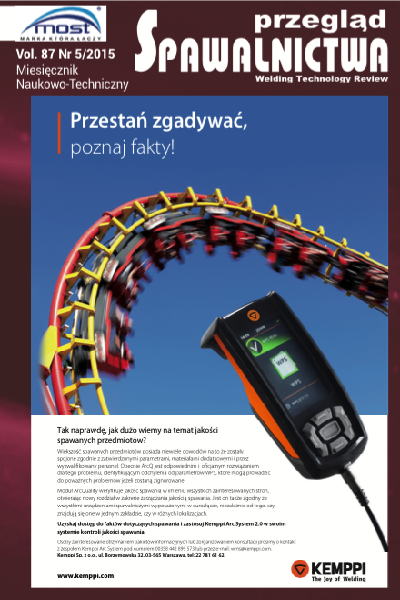Struktura zatrudnienia a ekonomia w robotyzacji procesów spawalniczych
Main Article Content
Abstract
Ciągły rozwój robotyzacji procesów produkcyjnych dyktuje niższe ceny rynkowe konstrukcji i wyrobów spawanych. Wdrożenie robotów spawalniczych w danym przedsiębiorstwie wiąże się z szeregiem zmian organizacyjnych także w strukturze zatrudnienia. Przedstawiono wpływ robotyzacji na zatrudnienie, kwalifikacje personelu oraz bezpieczeństwo i higienę pracy. Pokazano również możliwości pozyskiwania środków m.in. z funduszy unijnych na inwestycje w roboty i automaty przemysłowe.
The structure of employment versus economy in robotic welding processes
Abstract
Constant development of robotic manufacturing processes dictates lower market prices of welded structures and products. Implementation of welding robots is connected with many organizational changes, also in the structure of employment. The robotics influence on employment, personnel qualifications, and occupational health and safety are shown in this article. The possibility of obtaining money, among others, from EU funds for investment in industrial robots and machines is also described in the article.
Downloads
Article Details
Creative Commons CC BY 4.0 https://creativecommons.org/licenses/by/4.0/
Welding Technology Review (WTR) articles are published open access under a CC BY licence (Creative Commons Attribution 4.0 International licence). The CC BY licence is the most open licence available and considered the industry 'gold standard' for open access; it is also preferred by many funders. This licence allows readers to copy and redistribute the material in any medium or format, and to alter, transform, or build upon the material, including for commercial use, providing the original author is credited.
References
Bielski M.: Spawacze i automaty. Przegląd Techniczny, nr 5/2014.
Cieszkowska D.: Pieniądze dla firm cz. 1. Fundusze z UE 2014-2020, Dziennik Gazeta Prawna, luty 2015 r.
Ebel K.H.: The impact of industrial robots on the word of work. Robo- tics 2013.
Lee D., Kim J.: Development of a mobile robotic system for welding in the double-hulled structure of a ship, Robotics and Computer Integrated Manufacturing. 26 (1), kwiecień 2011
Lee D., Ku N., Kim T., Kim J., Lee K., Son Y.: Development and applica- tion of an inteligent welding robot system for shipbuilding. Robotics and Computer Integrated Manufacturing, 27, kwiecień 2011.
Łapiński K., Peterlik M., Wyżnikiewicz B.: Wpływ robotyzacji na konkurencyjność polskich przedsiębiorstw. maj 2013.
Oh M., Lee S., Kim T.: Design of a teaching pendant program for a mobile shipbuilding welding robot Rusing PDA. Computer Aided Design, nr 42, marzec 2010.
Popovic O., Prokic-Cvetkowic R., Burzic M., Lukic U., Beljic B.: Fume and gas emission during arc weldig. Hazard and recommendation. Renevable and Sustainable Energy Reviews, nr 37, wrzesień 2014.
Restecka M., Zeman W.: Innowacje modne hasło czy konieczność? Magazyn Przemysłowy nr 11(132)/listopad 2013.
Restecka M., Zeman W.: Innowacyjność producentów konstrukcji i wyrobów spawanych na przełomie lat 2012/2013 w oparciu o wyniki badań ankietowych. Praca własna, Instytut Spawalnictwa, listopad 2013.
Restecka M.: Robotyzacja trend ogólnoświatowy. Biuletyn Instytutu Spawalnictwa, nr 1/2015.
Sriram K., Lin G., Jefferson A., Store S., Afshari A., Keane M., McKinney W., Jackson M., Chen B., Schnegler-Berry D., Cumpston A., Cumpston J., Roberts J., Frazer D., Antoni J.: Modifiyng welding process parame- ters can reduce the neurotoxic potential of manganawe containing welding fumes. Toxicology, nr 328, luty 2015.
Strona internetowa: www.bhp.abc.com.pl
Strona internetowa: www.funduszeeuropejskie.gov.pl
Strona internetowa: www.ifr.org
Strona internetowa: www.robotyprzemyslowe.pl
